11 Best Dropshipping Suppliers For 2024 (Pros & Cons)
Welcome to our roundup of the best dropshipping suppliers.
Dropshipping is a fantastic ecommerce business model for beginner sellers.
It has a super low barrier to entry and you hardly need any capital to get started. The hardest part is finding a decent dropship supplier to work with.
That’s why in this post, we’ll be reviewing and comparing what we think are the best dropshipping suppliers on the market this year. And we’ll highlight the key features, pros, and cons of each one to help you compare your options.
The best dropshipping suppliers on the market
#1 – Spocket
Spocket is our top pick for the overall best dropshipping platform. It connects you to thousands of dropshipping suppliers all over the world, 80% of which are based in the EU/US.
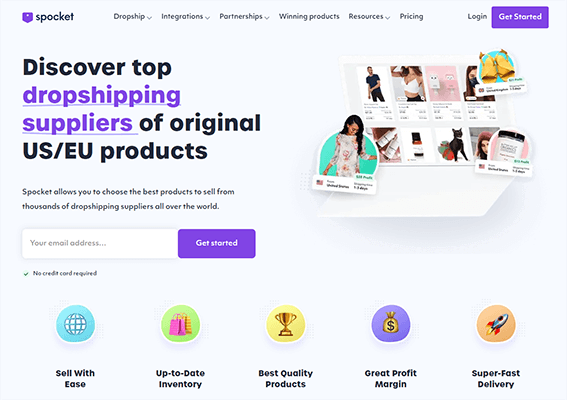
The way Spocket works couldn’t be more straightforward. It goes like this: You connect Spocket to your store, then browse their product catalog to find what you want to sell. Once you’ve found it, import it in a couple of clicks and you’re ready to start selling.
When a customer purchases a product from your store, their order is sent directly to your suppliers through Spocket’s automated fulfillment.
The supplier ships the product to the customer, and you keep the profit from the retail price.
The products on Spocket are some of the highest quality you’ll find anywhere, and there are dozens of categories to choose from: Clothing, accessories, toys, pets, gifts… you name it.
You can even use the ‘Trending’ filter to find hot products that are in high demand right now for easy wins.
Next to each product, you can see the listing cost and the average retail price at a glance, as well as the supplier location and average shipping times.
If you want to order a product sample to test the quality of a product you’re interested in selling, you can do so from your dashboard in just a few clicks.
Spocket integrates directly with all the major eCommerce platforms, including Shopify, WooCommerce, Ecwid, Wix, and Squarespace.
Key features
- EU/UK suppliers
- Trending product discovery
- AliExpress dropshipping
- Branded invoicing
- Supplier communication
- Image search
- 24/7 support
- eCommerce integrations
Pros
- Very easy to use
- Great UI
- High-quality suppliers
- Lots of suppliers in the EU/US
- Lots of supported integrations
Cons
- Product catalog isn’t as big as some other providers
- No customizable packaging
Pricing
Get started with Spocket’s Free plan. Paid plans start from $39.99/month, get up to 8 months off by paying yearly. 14-day free trial available.
#2 – Gelato
Gelato is the best solution for stores that plan on selling custom-printed products like t-shirts, mugs, phone cases, tote bags, and more.
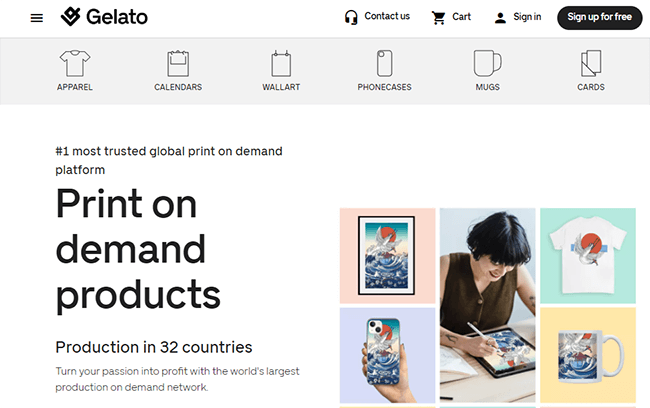
Gelato isn’t technically a dropshipping supplier. It’s actually advertised as a print on demand platform.
Print on demand (POD) is a specific variation of the dropshipping model, but it works pretty much the same way.
The idea is that you connect Gelato to your store and browse the catalog to find blank products that you’d like to sell. Then you upload your artwork/designs to them to create your own custom-designed mockups
After that, you import those products to your store and start selling them. When a customer places an order, Gelato handles fulfillment for you on demand. They send the order to the closest supplier to the customer’s country, who prints and produces the product and ships it out.
You only pay for what you sell, and you keep the difference between the base product cost and the retail price you sell for as profit.
There are a bunch of POD providers out there that offer the same sort of service, but Gelato is our favorite on account of its excellent product catalog, superior printing quality, high margins, and large global fulfillment network.
Key features
- Print-on-demand
- Automated fulfillment
- Global printing network
- Design maker
- Custom packaging
- Mockup studio
- Tax and VAT handling
- Multi-currency wallet
- Shipping discounts
- DTG printing
- 24/7 support
- eCommerce integrations
Pros
- Ideal for dropshipping custom-printed products
- Good margins
- Great catalog
- Outstanding quality
Cons
- Only print on demand products
Pricing
Get started with Gelato’s Free plan and only pay for what you sell. Paid plans start from $14.99/month or $139/year.
#3 – Dropified
Dropified is an advanced dropshipping automation solution. It’s a good choice if you don’t mind selling products from Chinese suppliers on sites like AliExpress and Alibaba.
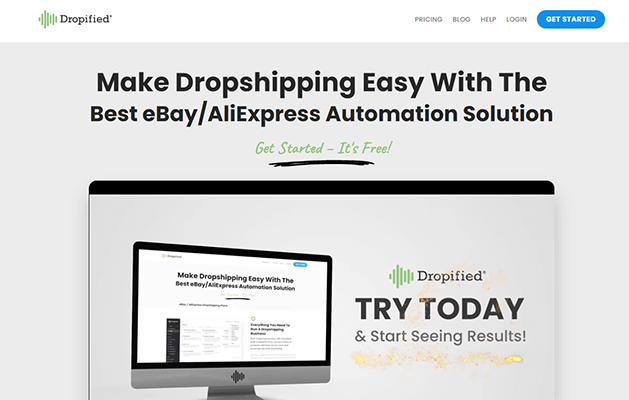
Dropfied makes it easy to discover, import, and sell profitable products through your dropshipping store. There are literally millions of products in their catalog to choose from, sourced from 75+ sites including AliExpress, eBay, Alibaba, and more.,
The user interface is super easy to use. Just browse their catalog and use rich filtering options to find what you’re looking for, then import products to your store in one click.
You can edit the images, headlines, descriptions, etc. to make your listings look exactly the way you want them to. And you can even import real product reviews from the supplier’s site to add social proof to your product pages, which helps boost conversion rates.
Dropified includes powerful automation features to help save you time on order management. For example, the Auto Fulfill feature allows you to automatically place orders with your suppliers whenever you make a sale, so you don’t have to do it manually.
You can even set it up to add custom notes to your supplier orders automatically. This comes in useful as you can ask them not to send any pricing/promotional materials to the customer.
Dropified can also automate pricing and inventory management. You can use Price Rules to set your own markups based on margins, shipping costs, etc. And you can turn on Alerts to have Dropified notify you about price or inventory changes. If a supplier runs out of stock, you’ll know about it straight away and can quickly add/change to a new supplier in a couple of clicks.
Dropified can also automatically list your products for sale on Facebook Marketplace for free to open up another sales channel and help you earn more revenue.
Key features
- Product imports from 75+ sites
- Automatic fulfillment
- Facebook Marketplace lister
- Product image editing tool
- Order/inventory management
- Custom order notes
- Automated pricing rules
- Review imports
- Profit tracking
Pros
- Great for AliExpress dropshipping
- Powerful automation tools
- Lots of supported integrations
Cons
- Fewer suppliers from the EU/US
- UI could be better
Pricing
Get started with a limited free plan. Paid plans start from $47/month, discounted to $39/month when paid annually. A 14-day free trial is available.
#4 – AliExpress
AliExpress is an international ecommerce marketplace based in China where sellers can source products from wholesalers and dropshipping providers at very cheap prices.
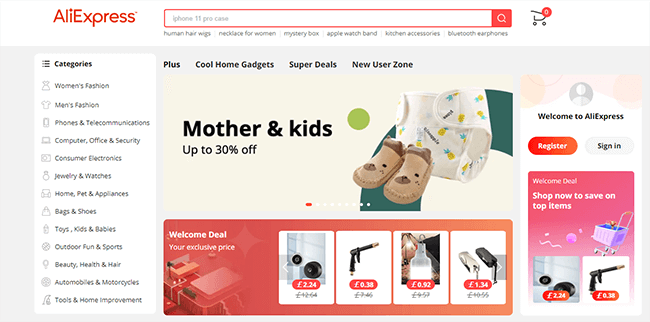
A lot of the most popular dropshipping apps (including Dropified) get the products featured in their catalogs from suppliers on AliExpress. So why not cut out the middleman and just go straight to AliExpress yourself?
There, you’ll find literally millions of products in every category you can imagine. Prices are super cheap, and vendors ship to 220 countries around the world.
The main downside is that, because AliExpress vendors are mainly from China, shipping can take a long time. Expect to wait 15-45 business days for standard shipping, or around 1-2 weeks for premium shipping.
Also, if you’re going to AliExpress directly, you’ll probably have to fulfill orders manually. That is, when a customer places an order through your store, it’ll be up to you to order that product from your AliExpress provider with the customer’s details to have it shipped to them.
If that sounds like a lot of work, you might want to use one of the other apps on this list that integrate with AliExpress and carry out auto-fulfillment for you, like Dropified.
Key features
- 100 million+ products
- Chinese suppliers
- Worldwide shipping
- Buyer Protection policy
- Help center
- Mobile app
- Affiliate program
Pros
- Very low prices
- Easy to get started
- Over 100m+ products to choose from
Cons
- Lots of low-quality products/suppliers
- Lengthy shipping
- Manual fulfillment (unless you use an app)
Pricing
It’s free to use AliExpress to find and order products from dropshipping suppliers.
#5 – Alibaba
Alibaba is the sister site to AliExpress, but it’s more geared towards B2B than B2C, so it’s a good choice for dropshippers who are also interested in buying bulk goods at the distribution level to sell to customers.
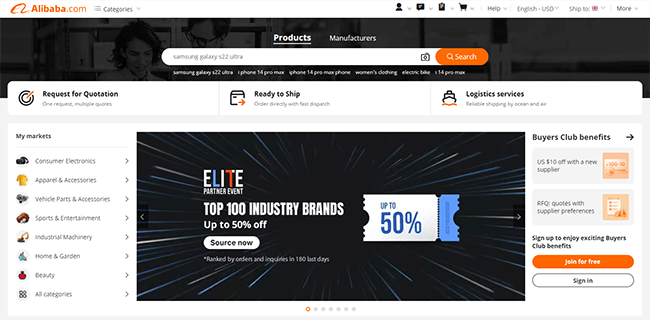
Like AliExpress, you can find millions of products on Alibaba from thousands of suppliers, mostly from China.
But because it’s designed as a B2B ecommerce marketplace, you’ll find suppliers on Alibaba are more likely to offer cheaper, wholesale pricing. And they also tend to be more flexible with production, so you can often request modifications like custom branded labels and packaging.
The flip side of that is that a lot of suppliers on Alibaba have minimum order requirements, so you may have to buy in bulk to get the best rates. That said, it’s possible to find suppliers that offer dropshipping and have no minimum order requirements too.
As with AliExpress, expect to wait weeks for deliveries from Alibaba.
Key features
- Supplier marketplace
- Filtering options
- Product search
- Logistics services
- Dropshipping
- Wholesale suppliers
- Mobile app
Pros
- Huge product catalog
- Good margins
- Easy to use
Cons
- More geared towards wholesalers than dropshippers
- Lengthy shipping
Pricing
It’s free to use Alibaba to find and order products from suppliers.
#6 – Modalyst
Modalyst is another fantastic dropshipping platform. It’s used by over 250,000 online businesses and is a good choice if you plan on selling fashion products like apparel, accessories, and jewelry.
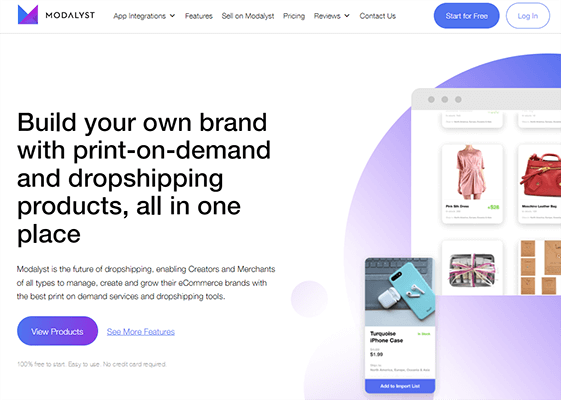
Modalyst gives you access to millions of best-selling products from vetted dropship suppliers in the USA, UK, Europe, Canada, Australia, and AliExpress.
It has its own plugins/apps for easy integration with Shopify, Wix, and BigCommerce. Once you’ve connected it, you can import products, customize them, and start selling with automated fulfillment.
Modalyst lets you set automatic pricing and shipping rules to systematically markup your products, saving you time.
And it also comes with a bunch of other useful features, including real-time inventory monitoring and shipping status updates. The latter notifies you when suppliers fill out the shipping status of your customer orders with the courier name and tracking information.
Key features
- Pre-vetter suppliers
- 1-click product imports
- Real-time product & inventory updates
- Order tracking
- Variant mapping
- Product editing
- Bulk add products
- Pricing automation
- eCommerce integrations
- Standardized contracts
Pros
- High-quality suppliers
- Trendy brands
- Great for fashion product sellers
- Lots of supported integrations
Cons
- Mostly fashion products
- Some Shopify users report app bugs and other issues
Pricing
Get started with the free plan. Paid plans start from $35/month and you can save up to 25% when you pay yearly.
#7 – SaleHoo
SaleHoo is a wholesale supplier directory worth checking out. It gives you access to thousands of the best dropshipping wholesalers from across the globe.
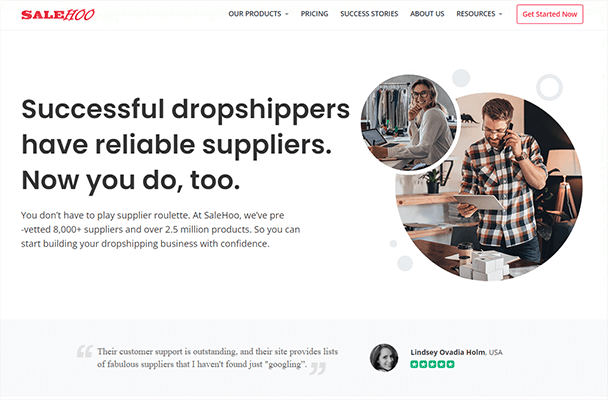
SaleHoo offers three different products: SaleHoo Directory, SaleHoo Dropship, and SaleHoo Educate.
SaleHoo Directory gives you access to their supplier directory, which contains over 8,000 pre-vetted vendors from across the world. These vendors offer over 2.5 million products altogether.
Signing up for SaleHoo’s Directory makes your life easier as you won’t have to comb through tens of thousands of dodgy sellers who deliver sub-par products on sites like AliExpress to find a supplier you can work with. They’ve done the leg work for you already.
Plus, SaleHoo members also get access to some exclusive insider deals that you won’t get anywhere else. And you can negotiate with suppliers through SaleHoo to get the lowest price for the best possible margins.
On top of that, signing up for the SaleHoo Directory also gives you access to their Market Research Lab. This is a really neat tool that allows you to dig into the data to find new business opportunities and plan your strategy. You can use it to view competition for products, calculate average profit margins, discover trending products, and more.
SaleHoo Dropship is a different product that’s priced separately from the directory. It gives you access to the Shopify App so you can connect your ecommerce store to SaleHoo for easy product imports and order management.
And SaleHoo Educate is a course designed to show you how to grow a successful ecommerce business.
Key features
- Supplier directory,
- Dropshipping app
- Market Research Lab
- Pre-vetted suppliers
- Product discovery
- Order management
- Product imports
- Online course (SaleHoo Educate)
Pros
- High margins
- Reliable suppliers
- Advanced features
- Great market research tool
Cons
- No free plan
- Only integrates with Shopify
Pricing
SaleHoo Directory plans start from $67 annually or $127 for lifetime access.
SaleHoo Dropship starts from $27/month, with 17% off when you pay annually.
#8 – Printful
Printful is another print on demand fulfillment provider that you can use to sell custom-designed merchandise globally.
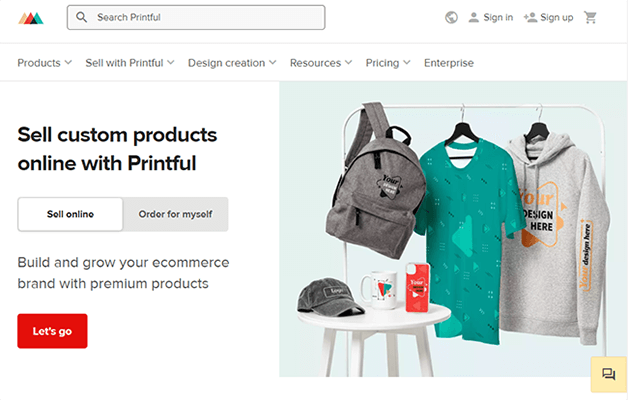
Printful works the same way as Gelato. You sign up, choose the products you want to sell, and customize them by uploading or creating your own designs in the Design Maker tool.
Then, you connect Printful to your ecommerce store via the app and import your custom merchandise to your own product catalog.
Whenever you make a sale, the order is sent to Printful, and they print it for you and send it to the customer. You only pay for what you sell.
There are over 340 products that you can sell with Printful including clothing, hats, homeware, accessories, wall art, drinkware, stationery, and more.
Printful owns 15 of its own globally-distributed fulfillment centers. That includes locations in the US, Europe, South America, and Australia. Orders are produced locally wherever possible for faster shipping.
And because Printful handles fulfillment in-house rather than outsourcing the job to third-party printers, printing quality tends to be more consistent and reliable.
Key features
- Print on demand fulfillment
- Automation
- Design Maker
- Global fulfillment centers
- White-label branding options
- Customizable packaging
- Inserts
- Logo maker
- eCommerce integrations
Pros
- Good quality
- Fully-owned production process
- Reliable
- Flexible branding options
Cons
- Print on demand only
- Low margins
Pricing
It’s free to use Printful—you only pay for what you sell. Optional premium add-ons can be purchased for additional fees.
#9 – Printify
Printify is another dropshipping & print on demand company that you can use to create and sell custom products.
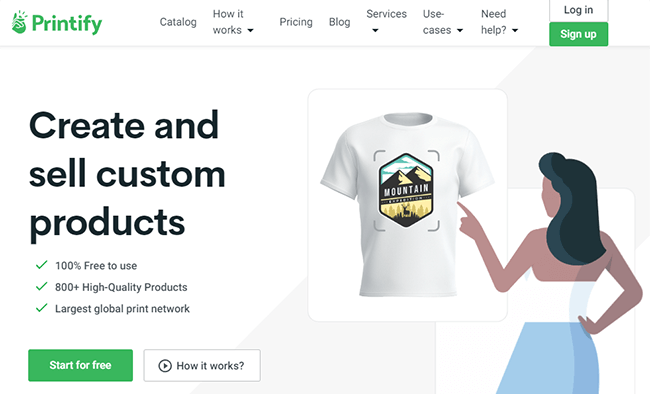
Printify and Printful have a lot in common. They both have a large global fulfillment network with printers all over the world and offer on-demand fulfillment.
And they both give you all the tools you need to create custom-designed products and sell them through your store.
However, Printify doesn’t use its own in-house facilities to produce its products. Instead, it works with a network of third-party providers.
While this does mean the quality of Printify’s prints isn’t as consistent as Printful, the advantage is that Printify’s prices tend to be lower as all its production partners compete for your business. As such, you can get better margins with Printify.
Printify also has one of the largest print on demand product catalogs I’ve seen. There are over 800 products to choose from, which can all be customized with your own designs.
- Key features
- Print on demand
- Global fulfillment network
- Geo routing
- Mockup generator
- 800+ products
- eCommerce integrations
Pros
- Great for dropshipping POD merch
- Large product catalog
- Competitive prices
- Large fulfillment network for easy international selling
Cons
- Inconsistent quality
Pricing
Get started with the free plan. Paid plans start from $29/month, get 14% off when you pay yearly.
#10 – US Direct (Inventory Source)
US Direct gives you instant access to over 200,000 dropship products from some of the best US suppliers.
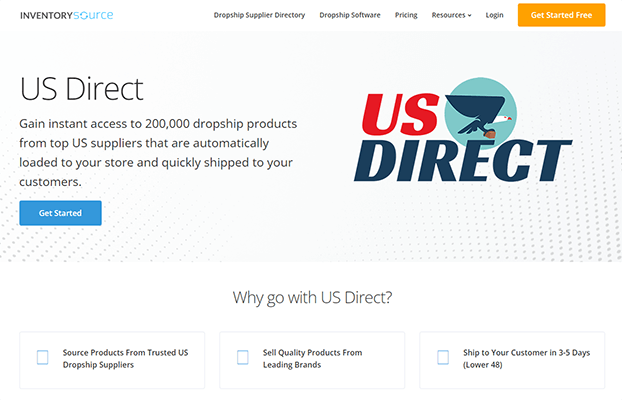
If you care about quality and you’re selling to customers in North America, US Direct is the way to go.
Its catalog only contains products from trusted US-based suppliers and brands, so quality is much better than the kind of products you get on sites like AliExpress.
And shipping is faster to North America too. Whereas you might be waiting weeks for deliveries on AliExpress, US Direct ships in just 3-5 days.
Usually, to partner with these kinds of top suppliers, you’d need to go through an approval process first. But with US Direct, you can skip all that and get straight to selling.
To import supplier products to your store and automate fulfillment, you can use Inventory Source—the dropshipping software behind the US Direct supplier database.
Key features
- 200,000+ products
- US suppliers
- Product imports
- Automatic fulfillment
- 3-5 day shipping
- Support center
- Integrations
Pros
- Quality US-based suppliers
- Ships in under a week
- Good support
- Advanced features
Cons
- UI could be better
- Paid plans are expensive
Pricing
Get started with Inventory Source by signing up for a free Directory Account. Paid plans start from $99/month.
#11 – Wholesale2B
Wholesale2B is another platform that provides access to over 1.5 million dropshipping products. Use it to sell to the US, Canada, UK, or anywhere else in the world.
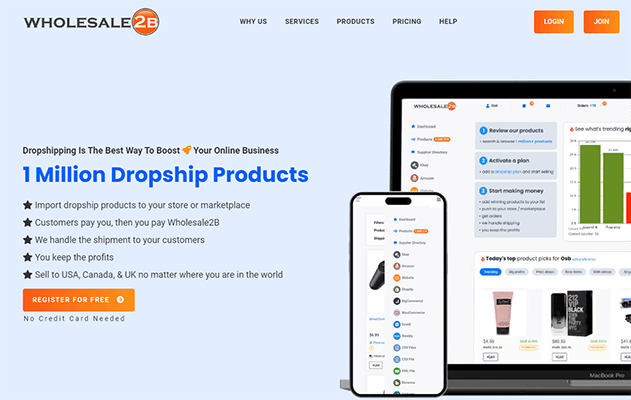
Over half a million customers use Wholesale2B to power their dropshipping business, so they must be doing something right.
It’s very easy to get started with Wholesale2B. You just have to sign up, browse their catalog to find products you want to sell, import them to your store or marketplace, and you’re ready to start selling.
When you make a sale, Wholesale2B handles production and shipping. The customer pays you the retail price you set, and you pay Wholesale2B the wholesale price—the difference is your profit.
It connects seamlessly to all the major ecommerce platforms so you can sell through Shopify, Weebly, Bonanza, BigCommerce, eBay, Amazon, and more.
Key features
- 1 million+ dropship products
- 100+ dropshipping companies
- Automated fulfillment
- Unlimited orders
- Price change alerts
- Top-selling product reports
- Order and inventory tracking
- eCommerce integrations
Pros
- Fast shipping to USA, Canada, and the UK
- Reliable
- Good quality products
- Easy to use
Cons
- Support could be better
Pricing
You can get started with Wholesale2B’s free account. Paid plans come with premium features and start from $37.99/month.
Frequently asked questions
Before we wrap up, here are the answers to some commonly-asked questions about dropshipping.
What is dropshipping?
Dropshipping is a type of retail business model in which the store itself doesn’t hold any stock.
Instead, they sell products at a markup and then purchase the products that their customers order from a third-party dropshipping supplier (usually a manufacturer or wholesaler). The supplier ships the product directly to the end consumer.
Is dropshipping legal?
First off, let’s be clear: We’re not lawyers so don’t consider this professional legal advice.
But as far as we’re aware, yes. Dropshipping is perfectly legal, at least in the US.
There’s something called the First Sale Doctrine in US law which essentially allows people who purchase a copy of a copyrighted item to resell that copy without infringing on the copyright owner’s rights.
This makes it legal for dropshippers in the US to resell products they legally acquire from suppliers without first obtaining permission.
But again, there are certain exceptions/limitations to this, and we’d always recommend consulting a lawyer before starting any business, including dropshipping.
What are the different types of dropshipping?
There are a few variations of the dropshipping business model worth knowing about:
- Classic dropshipping. This is when you sell products at a markup and order it from the supplier when you make a sale, who ships it to the customer for you. You keep the difference as profits.
- Private-label dropshippping. This is the same as classic dropshipping but you personalize customer orders by adding your own branded labels and packaging.
- Print on demand dropshipping. This is when you upload your designs to your supplier’s products to create custom-designed mockups and sell them through your own store. Your print on demand fulfillment provider then prints orders with your designs and ships them to customers on-demand, as sales come in. Learn more in our article on the pros & cons of print on demand.
- Product bundle dropshipping. This is where you bundle different products or parts from a dropshipping supplier’s inventory to create your own unique product (e.g. a subscription box) and sell that through your store. As with all dropshipping, the supplier handles the fulfillment.
What are the pros and cons of dropshipping?
The main benefit of dropshipping is how easy it is to get started with.
It’s much easier than traditional retail business models as you don’t need to purchase any stock upfront or pay for warehousing, so you hardly need any upfront capital.
Another cool thing about dropshipping is it’s easy to test and scale, which makes it very low-risk. You can try out a bunch of different ideas until you hit on something that works, and then scale up as needed.
And POD platforms like Gelato offer integrations with ecommerce stores such as Shopify, and popular marketplaces such as Etsy and eBay.
The main downside of dropshipping is the profit margins, which are typically much lower than traditional retail business models. So you need a high volume of sales to make a steady income.
The low barrier to entry also makes dropshipping very competitive so it can be tough to find a profitable niche. Plus, you have less control over inventory and fulfillment, and supply chain issues are common.
What are the best dropshipping niches?
No one can answer this question for you as the market is constantly changing. And if someone managed to find a super lucrative niche with low competition and high margins, they’d likely keep it to themselves (otherwise, it wouldn’t be a good niche for long).
That said, a good place to start when hunting for a niche is to look for trending products that demand is growing for. You can start with our roundup of 64 trending products to sell online this year.
To validate a niche, look at the average supplier price of the kind of products you might sell, and the average retail price that they sell for, then calculate the kind of margins you can expect. If you find something with high margins and low supplier prices, you’re in business.
It also helps to choose a niche that you’re familiar with/interested in and know how to market effectively.
How do I market my dropshipping store?
The best way to market dropshipping stores is probably social media advertising. According to a recent Reddit poll, 50% of dropshippers in a recent Reddit poll said their paid social ads drive the most sales.
You can run social ads on platforms like Facebook, Instagram, and TikTok. You’ll typically pay per click to your site, so it’s important to get your targeting right and optimize your store for conversions if you want to make sales.
Aside from social media advertising, you can also utilize other marketing channels including:
- SEM (paid search advertising)
- SEO (search engine optimization)
- Organic social media
- Email marketing
- Influencer marketing.
How do I find dropshipping suppliers?
Well, you can start by checking out the dropshipping services we’ve included in this post.
But if you’d prefer to search for dropshipping suppliers manually, here are some ideas you can try.
- Contact the manufacturers of the products you want to sell directly and ask for a list of suppliers that they work with
- Visit trade shows to meet suppliers and view products in person
- Order products from your competitors and search for the return address to find out who their suppliers are
Conclusion
As you can see, there’s no shortage of dropshipping vendors to choose from.
The right choice for your business will depend on what you want to sell, who your target market is, and the nature of your business.
When weighing up your options, you’ll want to consider factors like the supplier location, average processing and shipping times, prices, product offerings, product quality, integration possibilities, custom branding/packaging options, etc
That said, you really can’t go wrong with any of our top three picks:
- Spocket is the best dropshipping platform overall.
- Gelato is the best choice for selling print on demand.
- Dropified is the best choice for AliExpress dropshipping.
Not sure which ecommerce platform to build your dropshipping business on? Make sure you check out our guide to the 11 best ecommerce platforms of the year.
Disclosure: If you buy through links on our site, we may make a commission. This helps to support the running of Startup Bonsai.
